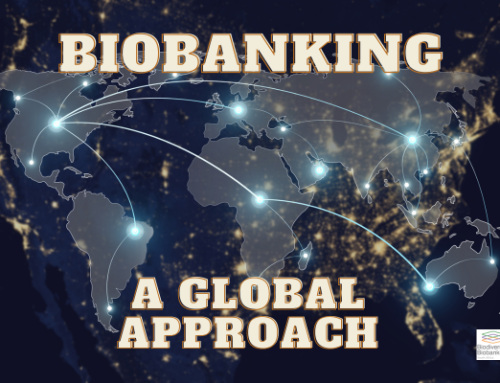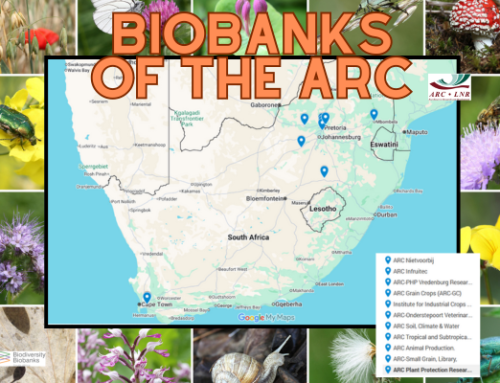Biobanks Africa 2025 | Same But Different – Biobanking As A Global Endeavour
“As biobankers, we’re all confronted with similar challenges – and in some ways they may be even more severe in developing countries. Here we have a lot of opportunities…but also a lot of responsibilities. And often, not a lot of resources to tackle them with.”
Those were the words of keynote speaker Prof Michelle Hamer at the opening of the Joint Biobanking Conference 2025 — the very first joint conference between the Global Genome Biodiversity Network (GGBN) and the International Society for Biological and Environmental Repositories (ISBER).

Prof Michelle Hamer delivering the keynote speech at the Joint Biobanking Conference 2025 – the biggest biobanking event in Africa.
The conference, hosted from 30 September to 3 October 2025 at the iconic Kirstenbosch National Botanical Garden, Cape Town, is bringing together experts in human and biodiversity biobanking to talk shop, share solutions and discuss future efforts.
Prof Hamer was speaking from long experience. An Honorary Associate Professor in the School of Life Sciences at the University of KwaZulu-Natal. She was employed from 2009 until the end of 2024 at the South African National Biodiversity Institute (SANBI) where she was responsible for establishing and leading two national research infrastructure projects, the Natural Science Collections Facility (from 2015) and the Biodiversity Biobanks South Africa (from 2018), which provides a coordinating structure across several of South Africa’s biodiversity biobanks.
“The BBSA network is a very wide range of institutions that do different things in diverse ways, operating in different contexts. How do you get them all working together, to have a common purpose, and a common strategy – because if everybody is doing their own thing, you’re not going to get much done,” she said. “We need one story – and it’s only late in my career as head of the BBSA that I found that story – by focusing on the bigger picture.”
The Kunming-Montreal Global Biodiversity Framework (GBF) provides a useful context for all types of biodiversity biobanks, and is strongly linked to fair and sustainable development and human wellbeing and health. The GBF has 23 targets, and one of these (Target 4) mentions ex situ conservation in the context of species conservation, but biodiversity biobanks have a potential role in achieving at least 18 targets.
“The Global Biodiversity Framework is part of the convention for biodiversity. Most countries support it and are in favour of achieving the targets. But biodiversity biobanks are not really explicitly mentioned there – but if you go through all those targets and think about biobanks more broadly, you’ll find they are important, and in some ways critical, for many of those targets.”
Apart from the most obvious role in species recovery and maintaining genetic diversity, she explained, biodiversity biobanks have a crucial role in measuring and monitoring biological communities, managing the spread of pathogens, development of new products, including nature-based solutions, forensic investigations, identification of components and origins of products, and rehabilitation and restoration of ecosystems. But this is only realistic if biobanks hold and provide access to an appropriate range of credible materials.
“So the GBF is a really valuable way of contextualizing biobanking – if, through all of it, we just ask ourselves: How can we as biodiversity biobanks play a real role in conserving biodiversity while still promoting research and human development? Answering that is going to be difficult…but critically important.”

The GGBN / ISBER Joint Biobanking Conference 2025 is bringing together biobanking experts from around the world to discuss challenges and opportunities faced by human and biodiversity biobanks.
Biobanking Around The World
The first official day of the conference saw presentations from all over the world, with biobankers from Chile to Uganda discussing their work on animals, plants and microbes, dealing with live cultures, tissue samples, DNA biobanking and more. Speakers delved into the challenges of collecting samples in different regulatory environments (or from wild animals in nature reserves), sharing of samples across borders, and even the use of biobanks to produce everyday consumer products (including two strains of citrus fruit currently available in Woolworths stores in South Africa).
This session explored the complex challenges and ethical dilemmas associated with biobanking in biodiversity-rich regions, with a particular focus on Africa. As one of the most biologically diverse continents, Africa holds vast genetic resources that are vital for scientific research, conservation, and innovation in healthcare and agriculture. However, biobanking in these regions is fraught with challenges, including regulatory gaps, resource constraints, and issues surrounding access, benefit-sharing, and indigenous knowledge protection.
Despite their varied programmes, there were still many common approaches and challenges – like the 1KSA programme from DIPLOMICS, a distributed network of institutions which aims to sequence 1000 organisms of importance in South Africa…which, as 1KSA Director Dr Shane Murray noted, was the same goal adopted by Chile’s 1000 Genomes Project, as described by Juliana De Abreu in her talk on Genomic Infrastructure for Chile: Design and Establishment of a Biobank through the 1000 Chilean Genomes Project.
Several members of the BBSA community presented about the particular histories, challenges and approaches of their biobanks, including Francinah Keneilwe Mosupye (SANBI Wildlife Biobank), Lindiwe Mokgakane (ARC-VMP), Elize Jooste (ARC-LNR), Seshnee Pillay (NRF-SAIAB), Nkotasi Mnisi (SANParks VWS-Kimberley) and Zinhle Manda (SANParks VWS-Kruger National Park).
Francina Bopape (ARC-LNR) and Victoria Wilman (SANBI Wild Plant Seedbank) also spoke about the complex challenges and ethical dilemmas associated with biobanking in one of the world’s most biodiverse regions – and one of the most threatened. Up to 25% of the country’s biodiversity may be gone by 2100.
“So how do we make sure our biobank has the most impact?” she noted. “We focus on endangered species, on economically important species. We look at threatened ecosystems, and focus on critical habitats in priority areas that have a high concentration of threatened species on them. And we do our best.”
It’s a daunting task, Prof Hamer noted. But the rewards can be great.
“As a biodiversity biobanker, you’ll probably never be rich. You may never be famous. But you may help save the world – and I think that makes it all worth it.”
For more information on any of the talks mentioned, or the rest of the conference, please consult the programme online. And for all those interested in attending, online registration is still available – just visit the Joint Biobanking Conference website to find out more!

What are biodiversity biobanks?
Biodiversity biobanks are repositories of biologically relevant resources, including reproductive tissues such as seeds, eggs and sperm, other tissues including blood, DNA extracts, microbial cultures (active and dormant), and environmental samples containing biological communities….







